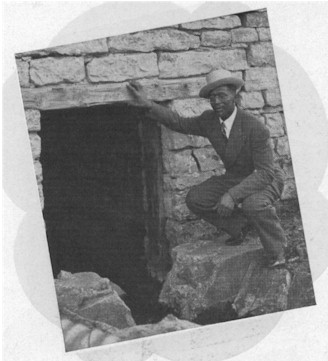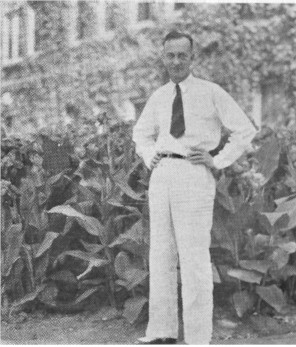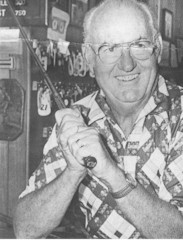|
|||||||||||||
|
|||||||||||||
|
|||||||||||||
|
|||||||||||||
| In the Beginning | |
| The
golf course that now quietly resides next to the hustle and
bustle of Old Hickory Blvd. was once the residence of the French
Huguenots family, the Bondurants. The Bondurants left France due
to Catholic persecution and moved to Virginia. In 1803, the
family moved to this area after purchasing 405 acres of
land. This family is considered by some historians to be the
first permanent residents in this area.
The original Bondurant house was torn down at one point and replaced with a replica. This replica is the house we know of today as the Old Hickory Golf and Country Club. Oddly enough, the Bondurant house and the Donelson home "Cleveland Hall" are the only homes that are still standing that were located on property purchased by the United States Government in 1918 for construction of the Munitions Plant. Note: "Cleveland Hall" is the large brick house across from Andrew Jackson Elementary. During the Powder Plant years, the entrance to the Powder Plant property was where the entrance to the Brandywine Farms neighborhood is today which is across the street from "Cleveland Hall". |
|
| DuPont
Employee Family Served Bondurant Family Rayon Yarns, September 1940 |
|
|
|
|
| In a
little log cabin located near the spring on the present Golf Club
grounds, Jim Winters was born on December 9, 1887. Jim, who works
in Plant Service and has some 18 years' Company service, has a special
attachment to the Golf Club for that reason, and it is his ambition to
work at the beautiful club near the spot where he was born. At the
time of his birth, Mr. Joe Bondurant, of one of the Hadley Bend's famous
old families, lived in the Bondurant house, which was later used as the
golf club and was torn down and replaced by the present building.
Jim's folks, before the Civil War , were plantation slaves and "belonged to the white folks," to use his own expression. His grandfather Winters "belonged" to the Ed Winters family of Wilson County, and his maternal grandfather, Ned Davis, "belonged" to the Isom Davis family, also of Wilson County. "Uncle Ned" died at the age of 95, shortly before World War I, on the Sam Johnson place in Hadley Bend. When Jim was a "little bitty baby," before he had even been given a name, his father moved to the Miller Turner place. Jim was named James Miller Winters, but has always gone by plain "Jim." He started working at Old Hickory during Powder Plant days. He worked for the Government in the railroad yards, and one of his duties was to walk down the tracks every day to the junction on Stone's River and look for loose bolts, obstructions on the tracks, etc. He would walk down to the junction and ride the passenger train back to the yards. There were six or seven passenger trains each day and all were loaded to capacity, with workers even hanging on the outside. The track was double at that time. Jim vividly recalls the flu epidemic of 1918 and remembers that the basement of the Y building was used as a temporary morgue where bodies of the hundreds of people who died of the dread ailment were laid out until trucks could haul them into Nashville. He relates one gruesome incident when one body was lost off in Donelson and wasn't even missed, until another truck came along and picked it up. Jim is one of the few employees who were born in Hadley Bend and may be the only one of his generation who has spent his entire life in this immediate vicinity. He has never been lived than five or six miles from the spot where he was born and has never been out of Tennessee. He isn't exactly untraveled, however, for he made a trip to Chattanooga once. Jim lives with his wife at Hopewell now, where they own their home. They have seven children. |
|
| The
old spring house at the Golf Club was used before the Civil War for
cooling milk and butter. The stone foundation is more than 100
years old, the log portion at least 75 or 80 years old. Jim
Winters' mother used to take care of the dairy on the Bondurant place
and made many a trip down the hill from the big house to bring up cold
milk and firm golden butter from the spring house. She was
the mother of 21 children.
|
 |
|
|
|
| The Father of Golf in Old Hickory | |
 The
career of R.L. Megee with the du Pont Company began in 1915 at Carney's
Point, N.J. His first job was as outside time-keeper in the Engineering
Department. He was transferred in 1919 to Jaynesville, Wisconsin,
on construction work for General Motors. A year later the Company
sent him to Parlin, N.J. In 1921 where the Marine Terminal was
being built. In the fall of 1923 he came to Old Hickory as Chief
Clerk in the Engineering Department. "Bob" as he is
familiarly known, was later General Accountant of the du Pont Old
Hickory Rayon plant and shift supervisor in Spinning. In 1929 he
was appointed Employment Supervisor, Personnel Supervisor in 1936, and
on January 1, 1940, Service Superintendent, the position which he now
fills. The
career of R.L. Megee with the du Pont Company began in 1915 at Carney's
Point, N.J. His first job was as outside time-keeper in the Engineering
Department. He was transferred in 1919 to Jaynesville, Wisconsin,
on construction work for General Motors. A year later the Company
sent him to Parlin, N.J. In 1921 where the Marine Terminal was
being built. In the fall of 1923 he came to Old Hickory as Chief
Clerk in the Engineering Department. "Bob" as he is
familiarly known, was later General Accountant of the du Pont Old
Hickory Rayon plant and shift supervisor in Spinning. In 1929 he
was appointed Employment Supervisor, Personnel Supervisor in 1936, and
on January 1, 1940, Service Superintendent, the position which he now
fills.
In the years at Carney's Point and Parlin he caught for the plant baseball teams. Several of the players with or against whom he played later went to the Big Leagues. One of the most notable of them was Goose Goslin. At the time "Bob" came to Old Hickory, there were no available facilities for playing golf. He, with Major Krupp, who had charge of the Government property here, and the late B.P. Morse of the Nashville Industrial Corporation, started a three hole course near the site of the Presbyterian Church. Later, "Boss" Robinson gave permission to lay out six holes around his home which was on the site of the present golf course. The new Club House of which Old Hickory is soon to be proud, must be credited to a considerable degree to his untiring efforts. In addition to baseball and golf. "Bob" is an ardent hunter. He is particularly fond of quail and dove shooting. The sport, however, which he enjoys most is fishing, although he calls himself the "world's worst fisherman."
|
|
|
|
|
| Memorable Leader Got Start at Rayon Plant | |
| The Old Hickory Record - August-September 1979 | |
 In
the Du Pont Company, if there's any such thing as a "labor of
love" it'd be hard to look much past Harold Eller. In
the Du Pont Company, if there's any such thing as a "labor of
love" it'd be hard to look much past Harold Eller.
Harold has been working at something close to his heart for 34 years. Golf has not only been the game he enjoys most, but also his business. Harold, or "Big Daddy" as he's affectionately known around Old Hickory fairways, will be calling a halt to the working portion of his game when he retires Oct. 1 as golf professional of the Old Hickory Country Club. Through his career as club pro would seem full enough, as a pensioner his memory bag will also contain 13 years of employment as an operator in Rayon. In all, that's 47 1/2 years with Du Pont, the most of any active employee. He started with Du Pont in 1932, working on what were known as "sipp machines" in the Textile area. "I started at 25 cents an hour, but at least I got to keep it all since it was before Social Security," he said. Life wasn't to be all work, through, particularly for an 18-year-old with a decided knack for striking a golf ball. Introduced to the game as a 12-year-old caddy at famed Oakland Hills in Birmingham, Mich., Harold was a near par shooter by the time hi family returned to his native Tennessee in the late 1920s. He joined the Old Hickory Country Club ("among the first from the wage roll") within months of beginning in Rayon, and established himself among the more talented golf strokers, winning three consecutive club championships in the early '40s. Then, in months following World War II when he was on a special assignment to help start up a fourth shift in Rayon Spinning, a call came that was to change the direction of his life. "The call was from Bob Magee, Personnel Superintendent, and he asked if I wanted the club pro job," Harold recalled. "I had been suggesting others, but finally decided to go ahead and take the job. I guess I'm fortunate he didn't pay any attention to my suggestions." The decision to hire Harold was not only a turning point for him, but was to affect golfers by the hundred in Middle Tennessee in coming years. |
|
|
|
|
| DuPont and Club Go Separate Ways | |
| Historic
Relationship Will Soon End Old Hickory Record - Winter 1988 The Du Pont Co.'s ownership of the Old Hickory Country Club - a relationship almost as old as the company's presence in this area - will conclude March 31 when members assume club reins. Club membership voted overwhelmingly to purchase the facility from Du Pont for $1.5 million. The purchase price was raised through the sale of charter memberships. Cost of a full membership, including all athletic and social privileges, was $5,000. The club has been owned by Du Pont since 1926 when it was constructed for rayon plant employees. For many years Old Hickory's membership has leased the club from the company for a nominal fee, with the club paying all taxes and maintenance costs. Among the current membership, only about 30 are active employees and 90, retirees - a participation rate that influenced Du Pont in its decision to sell the 135-acre facility, according to Gene Chambers, the company's representative on the club's Board of Governors. This compares to membership that not many years ago consisted overwhelmingly of Du Ponters. Du Pont had considered "for quite some time" divesting itself of the club since the number of Du Pont members had dropped so low, Gene said. The sale notwithstanding, Du Pont hopes to continue its relationship with the club in such matters as holding meetings, luncheons and other functions as it has for so many years, Gene said. From the club members' view, Du Pont's asking price for the facility "was a generous offer," said Fran Dacri, club president. While noting that the Du Pont Co. and club members have enjoyed a "positive relationship for many years," Fran added that "the people like the idea of owning their own club. There's a certain pride in owning something yourself." Currently there are 425 members. "There is no doubt that this number will grow, and that we will be successful," Fran said. Features to attract new members include the golf course itself -- "one of the best in this part of the country, with new bent-grass greens," Fran said. "We have full country club facilities at a bargain price, with swimming and tennis facilities plus banquet facilities, meeting rooms and a full service restaurant." Du Pont disclosed plans to sell the club last summer, and the transaction is expected to be completed March 31, 1989. |
|